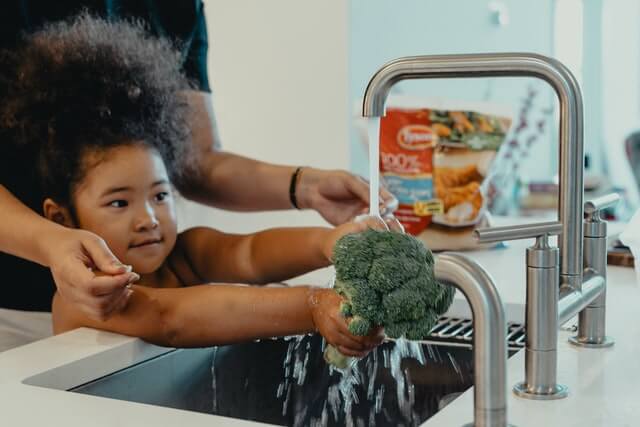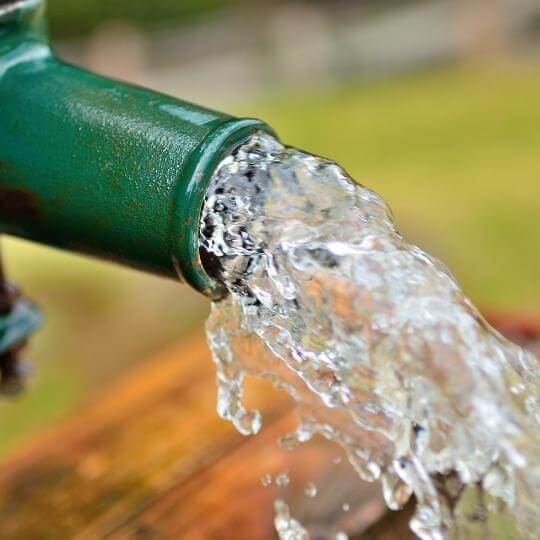Do you get your water from a well system? This is an excellent facility as using a well enables you to save money on water bills.
On the other hand, relying on your well for daily water use means you can deal with other issues. One of the most common problems is low water pressure on well.
This can be very annoying as your appliances may not function properly without optimal water pressure. Not to mention the annoyance of taking a shower with water barely pouring!
How is water extracted from a well?

In order to find out what is causing low water volume from well, first you need to understand how things work.
How does water exactly reach the surface and your plumbing system?
Even if people imagine wells taking water from underground rivers, the reality is a little different. [1]
Most wells actually get water from aquifers.
Aquifers are layers of rock and soil mixed with water. The water flows through the small rock pores. This phenomenon only happens below the water table, the barrier between unsaturated and saturated ground.
If you dig a hole deep enough to go beyond the water table, it fills with water. You can retrieve that water using various techniques, from the simple bucket on rope to electric pumps.
What is the optimal water pressure?
Optimal water pressure for use in a home is anywhere between 40 and 60 psi. Most homeowners prefer something in the middle. [2]
You can determine the exact water pressure from your well using a water pressure reading.
Don’t have a water pressure gauge?
A simple technique to determine whether you have water pressure problems is the multi-flow test.
This test consists of running a washing machine, turning on a couple of sinks in the house, and the shower. If the water flow is not strong enough on all appliances, it means you need to increase your water pressure.
What can cause low water pressure on a well?

So, let’s deal with the sore spot – low water pressure on well.
Low well water pressure is no surprise, especially when you use gravity to pressurize water.
There are multiple possible causes for this:
- Increased water use
This is a no-brainer – if you turn on all points of use in your home, water pressure will drop. Also, if you add a new bathroom or an irrigation system, you will notice that well pump pressure drops suddenly.
Before expanding your plumbing system, ask an expert and see if your well can meet a higher water demand.
- Drought
Since well water comes from nature, a reduced amount of precipitation water can influence water pressure.
There is lots of water saturating the ground under the water table; however, too much drought can cause problems. Your well will eventually be starved of resources and water pressure will drop.
Drought can represent a problem if your well is already running on a low supply. If lack of rain adds to the equation, you will lose water pump pressure gradually.
- Mechanical problems
The mechanical system you use to bring water to the surface can be subject to deterioration. A common cause of mechanical issues is sediment buildup in pipes.
Other problems with your well pump can be clogged screens, stuck valves, broken and corroded pipes.
This is why you need to service your water pump regularly, before problems develop.
- Pressure switches not set properly
Many homeowners try to solve the water pressure problem by adjusting the pressure switch. Sometimes this works.
Adjusting the pressure switch produces no results? This means your pump is not able to build the high pressure you require.
There is also a possibility for the pressure switch to be defective. If you suspect this, best is to call a professional as there are live wires inside.
- Failed pressure tank
Pressure tanks include captive air bladders which holds a certain amount of air pressure amount.
In order to check pressure tank, turn off pump power and let go of water pressure in the tank.
- Clogged well pipes
Remove a section of the well pipe and inspect it. If the pipe is filled with sediment, the sludge may be reducing your water pressure.
- Issues with water filters
Are you using water softeners or a backwashing filter? Check pressure before and after the filter to determine whether the filter is causing pressure loss.
- Clogged fixtures
Remove fixtures such as showerheads and faucet aerators and check for scale and sediment. Even if you have good well pressure, a clogged aerator can reduce it. Clean with vinegar or an acidic solution to restore normal water flow.
- Malfunctioning pressure regulator
Do you have a pressure regulator on the main pipe coming into your home? if the regulator goes bad, it needs to be replaced.
- Clogged or bad valves
When you are not using valves for a long time, they can get stuck. It is possible to clean valves from sediment, but best is to replace them.
How can you increase water pressure?

Before recommending some fixes, we need to outline the difference between water pressure and flow rate.
The flow rate refers to the number of gallons that flow through a pipe per minute.
It’s possible to have good water pressure coming from the well, but an unsatisfactory flow rate in your home. This indicates that low water pressure at faucets is not necessarily equal to low water pressure on well.
If you want to boost your flow rate use pressure booster pump.
Have you noticed water pump loses pressure quickly?
Here are some ideas on how to increase water pressure from a well:
- Install a constant pressure system
This is a fast and cost-effective method for ensuring satisfactory water pressure. These systems are designed to compensate for heavy water use by regulating the pressure of water-using fixtures in your home.
How do they work?
They maintain a set level in your water tank by drawing supplementary water from your well. This means the water is ready to use when you need it.
- Inspect the well
The well itself can be the culprit for low water pressure on well. It is possible not to have enough water available to be drawn. The remedy for this is either deepening your well or lowering your pump.
- Inspect the water pump
First of all, are you sure you are using the right water pump? For instance, centrifugal-style pumps are not suited for deep wells. Jet pumps are reliable for all well depths, but you need to check them every once in a while, too.
- Clean the pipes
Well water is not just pure water, but it also contains minerals and organic matter. If your well has hard water, a buildup of mineral deposits will develop sooner than you expect. This causes pipes to shrink their diameter and water will no longer flow freely. Worst case scenario, you will need to replace entire sections of the pipe.
- Check for leaks
Damaged pipes or pumps can result in water leaks; water is lost as it travels through the pipes.
Galvanized steel pipes are vulnerable to corrosion. If they are rusty, it’s time to replace them with PVC or copper. This project can cost a good deal of money and cause disruption, but upgrading your pipes is important. When corrosives are no longer contaminating your drinking water, your health and safety are protected.
- Adjust the water pressure
Most contemporary houses have a pressure-reducing valve on the supply line entering the house. That valve is very simple to operate and will either increase or reduce water pressure.
The valve is usually found near your water meter in the basement or in the crawlspace. It’s made of brass, has a bell-shaped middle section and a screw at the end of the bell.
In order to increase your water pressure, you need to tighten the screw by turning it clockwise. Turning the screw counter-clockwise decreases water pressure. Measure the water pressure after each adjustment.
The Verdict
There are multiple ways to troubleshoot low water pressure on well. You will need to investigate the matter a little and see what is causing the problem. It can be the well itself, the pump, your fixtures, the pipes, or a pressure regulator. By addressing the real cause of low water pressure, your situation will most likely improve.

Michael Davis is a heating & plumbing expert who currently works as independent contractor in SC. He also writes for Plumbertip.
For almost 10 years he worked on various plumbing tasks across South Carolina.



